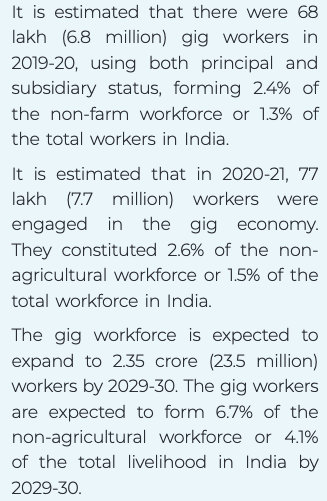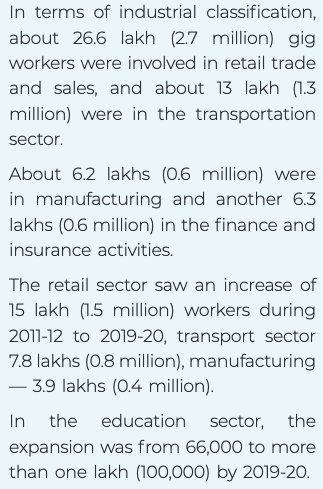

New Delhi: The rise of the gig economy in India is changing the face of its workforce. The current estimation for gig economy jobs in India is at 8 to 18 million, which is projected to increase to over 90 million jobs in the non-farm sector in the next eight to ten years. Therefore, by the next decade, the gig economy in India can see USD 250 billion transactions at 1.25% of the country’s Gross Domestic Product.
For India, four industry sectors can be identified as the ones with the highest potential to produce “gigable” jobs in the future — Construction, Manufacturing, Retail, and Transportation and Logistics. These sectors are together expected to accommodate over 70 million potentially “gigable” jobs in the future.
However, the gig economy is fast-expanding and its presence can be noticed in other industries such as textile, banking and financial services, electricity, gas and water; real estate, IT and ITES, education, and personal services.
Currently, more than 75% of the companies have less than 10% gig headcount, but this proportion is bound to rise with MNCs turning to flexible hiring options
Shifting the focus to the platform economy, a subset of the gig economy, in the next three to four years, about 24 million jobs could be converted to technology-based gig labour (i.e. platform work), with about three million jobs in shared services and another eight million jobs servicing household demand estimates that eleven platforms in India report about 30 lakh workers in 2020.
 Therefore, the increasing prominence of gig and platform workers needs to be acknowledged, if India is to leverage the full potential of this new-age workforce.
Therefore, the increasing prominence of gig and platform workers needs to be acknowledged, if India is to leverage the full potential of this new-age workforce.
The gig and platform economy is a relatively new and emerging sector with immense potential for growth and employment generation.
A gig worker is a person who engages in income-earning activities outside of a traditional employer-employee relationship, as well as in the informal sector. When gig workers use platforms – i.e., websites or apps like Ola, Uber, Dunzo, Zomato, Swiggy or Urban Company – to connect with customers, they are called platform workers.
Platform workers are one of the most visible groups of professionals in urban India today. Through the app, they could receive a work order which might involve ferrying passengers around in taxi-cabs, auto-rickshaws, bike-taxis and their electric vehicle variants, delivering food and groceries, or providing cleaning or wellness services at home.
The Economic Survey 2020-21 has noted that India has already emerged as one of the world’s largest countries for flexi-staffing (i.e., gig and platform work) and that this form of work will likely continue to grow with the increase in e-commerce platforms. This changing scenario calls for the need to assess the employment generation potential of the gig and platform sector and design policy measures that can invigorate efforts from different stakeholders to promote growth along with decent work opportunities in this sector.
 NITI Aayog today launched a report titled ‘India’s Booming Gig and Platform Economy’. The report was released by NITI Aayog Vice-Chairman Suman Bery, CEO Amitabh Kant and Special Secretary Dr K Rajeswara Rao.
NITI Aayog today launched a report titled ‘India’s Booming Gig and Platform Economy’. The report was released by NITI Aayog Vice-Chairman Suman Bery, CEO Amitabh Kant and Special Secretary Dr K Rajeswara Rao.
The report is a first-of-its-kind study that presents comprehensive perspectives and recommendations on the gig–platform economy in India.
The key objectives of this study are estimating the size of the workforce engaged in the gig and platform economy, highlighting both the opportunities and the challenges of this emerging sector, presenting global best practices on initiatives for social security and outlining strategies for skill development and job creation for different categories of workers in the sector through a set of comprehensive recommendations. The report provides a scientific methodological approach to estimate the current size and job-generation potential of the sector. It highlights the opportunities and challenges of this emerging sector and presents global best practices on initiatives for social security and delineates strategies for skill development and job creation for different categories of workers in the sector.
Speaking on the occasion, NITI Aayog Vice-Chairman Suman Bery said, “This report will become a valuable knowledge resource in understanding the potential of the sector and drive further research and analysis on gig and platform work.”
CEO Amitabh Kant highlighted the job creation potential of this sector given rising urbanization, widespread access to the internet, digital technologies and smartphones in India. He said, “The recommendations in this report will serve as a crucial resource for ministries, state governments, training providers, platform companies and other stakeholders to work in collaboration for promoting growth and employment opportunities in this sector.”
Special Secretary Dr K Rajeswara Rao presented the key findings and recommendations of the report.
The report estimates that in 2020–21, 77 lakh (7.7 million) workers were engaged in the gig economy. They constituted 2.6% of the non-agricultural workforce or 1.5% of the total workforce in India.
The gig workforce is expected to expand to 2.35 crore (23.5 million) workers by 2029–30. Gig workers are expected to form 6.7% of the non-agricultural workforce or 4.1% of the total livelihood in India by 2029–30. At present, about 47% of the gig work is in medium-skilled jobs, about 22% in high skilled, and about 31% in low-skilled jobs. The trend shows the concentration of workers in medium skills is gradually declining and that of the low skilled and high skilled is increasing.
To harness the potential of the gig-platform sector, the report recommends accelerating access to finance through products specifically designed for platform workers, linking self-employed individuals engaged in the business of selling regional and rural cuisine, street food, etc., with platforms to enable them to sell their produce to wider markets in towns and cities. The report puts forth suggestions for platform-led transformational and outcome-based skilling, enhancing social inclusion through gender sensitization and accessibility awareness programmes for workers and their families and extending social security measures in partnership mode as envisaged in the Code on Social Security 2020. Other recommendations include undertaking a separate enumeration exercise to estimate the size of the gig and platform workforce and collecting information during official enumerations (Periodic Labour Force Survey) to identify gig workers.
– global bihari bureau





